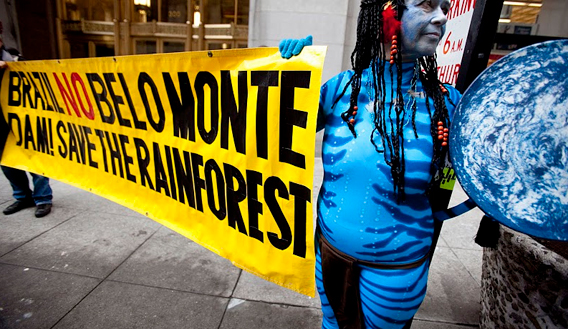
San Francisco protest. ©Caroline Bennett/Amazon Watch
Protesters in dozens of cities demanded Brazil abandon a plan to build a dam on one of the Amazon’s largest tributaries, reports Amazon Watch, an NGO that helped organize the events.
Amazon Watch says outrage over the Belo Monte dam, which will block the Xingu river, flooding more than 40,000 hectares of rainforest and displacing over 20,000 people, resulted in demonstrations 15 Brazilian cities on Saturday and 23 cities in 17 countries on Monday. Protesters also criticized a move by Brazil’s Congress to weaken the country’s Forest Code, which requires landowners to maintain substantial areas of forest on private lands. The push to rollback the Forest Code is being lead by agroindustrial interests and is opposed by indigenous groups, small farmers, scientists, and environmentalists.
“These protests were organized via social media networks. This is a new chapter in the struggle to defend the Amazon, and everyday more people are getting involved,” said Christian Poirier, Brazil Program Coordinator at Amazon Watch. “The Dilma Rousseff government is at crossroads. The world is calling on her to demonstrate courage and leadership and take immediate actions to safeguard the Amazon for future generations.”
Amazon Watch notes that some 1.4 million people have so far signed a online petition posted by Avaaz demanding the Rousseff government cancel Belo Monte and veto any weakening of the Forest Code.
Related articles
(07/17/2011) Curt Trennepohl, president of Brazil’s environmental protection agency (IBAMA), caused an uproar last week when he told an Australian TV crew that his agency’s role “is not caring for the environment, but to minimize the impact”. Later when Trennepohl believed the cameras were off he went on to say Brazilian indigenous tribes would suffer the same fate as Australia’s Aborigines, reports Folha de S.Paulo.
Deforestation in Brazil’s Amazon continues to rise; clearing highest near Belo Monte dam site
(06/17/2011) Deforestation in the Brazilian Amazon continued to rise as Brazil’s Congress weighed a bill that would weaken the country’s Forest Code, according to new analysis by Imazon.
Last chance to see: the Amazon’s Xingu River

(06/15/2011) Not far from where the great Amazon River drains into the Atlantic, it splits off into a wide tributary, at first a fat vertical lake that, when viewed from satellite, eventually slims down to a wild scrawl through the dark green of the Amazon. In all, this tributary races almost completely southward through the Brazilian Amazon for 1,230 miles (1,979 kilometers)—nearly as long as the Colorado River—until it peters out in the savannah of Mato Grosso. Called home by diverse indigenous tribes and unique species, this is the Xingu River.

(06/03/2011) As an American I know a lot about shame — the U.S. government and American companies have wrought appalling amounts of damage the world over. But as an admirer of Brazil’s recent progress toward an economy that recognizes the contributions of culture and the environment, this week’s decision to move forward on the Belo Monte dam came as a shock. Belo Monte undermines Brazil’s standing as a global leader on the environment. Recent gains in demarcating indigenous lands, reducing deforestation, developing Earth monitoring technologies, and enforcing environmental laws look more tenuous with a project that runs over indigenous rights and the environment.







